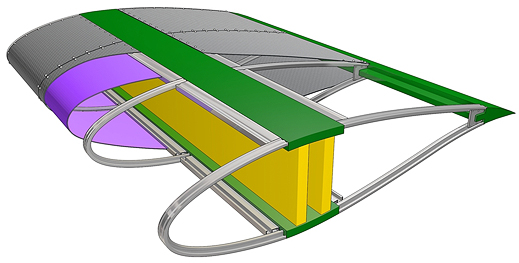GE Hopes to Make Its Cloth Wind Turbine Idea Fly
GE hopes to make wind turbines far cheaper, and open up new ways to design them, by ditching the stiff fiberglass blades it uses now in favor of turbine blades made out of fabric. GE says the project, which recently received nearly $4 million from the U.S. Advanced Research Projects Agency for Energy, could lower wind turbine blade costs by 40 percent.

One way to reduce the cost of wind power is to make larger turbines. But as the blades have been getting larger, the costs of making them have been rising as well, says Wendy Lin, a principal engineer at GE. That’s offsetting some of the advantages of bigger turbines. “We know we really need to make a drastic change in the way we make these blades to bring the cost of the system down,” she says.
GE intends to use a fabric that’s significantly different from the durable fabrics used now in architecture (such as for the roof of the Denver airport) or for gliders. Such projects use polyester, which wouldn’t be durable enough for wind turbines, Lin says. Instead, GE plans to use glass-based fabrics. Indeed, even current fiberglass wind turbine blades start with glass cloth. The blades are made stiff by cementing the fabric with stiff plastic resin. GE plans to use a soft, rubbery resin instead, allowing the fabric to retain some flexibility. That flexibility will make it more resilient than stiff fiberglass, which will in turn allow GE to use less material, reducing materials costs and weight.
The design calls for a frame that’s similar to the spars and ribs used in airplane wings. The fabric is stretched over that frame. This structure could be far cheaper to manufacture than fiberglass blades, which require forms that are so large that workers walk inside them to lay down layers of glass fiber. There’s plenty of room for error in this labor-intensive process, so highly skilled, expensive workers are needed.
The new design won’t require large, expensive forms, and the blades could be made in a more automated fashion.
If GE can reduce the cost of the blades by 40 percent, it would lower overall wind turbine costs by as much as 10 percent. The benefits may go beyond this cost reduction, since the fabric-based blades could allow for new designs, including blades that change shape to accommodate changing wind conditions. The new manufacturing methods would also eliminate the restrictions on blade size imposed by the difficulty of transporting long, wide blades, making larger wind turbines practical (see “A Mighty Wind Turbine” and “Building Bigger, Better Wind Turbines”). GE says it might eventually assemble the blades on site rather than in a factory.
Under the ARPA-E program, GE will determine how best to fabricate the blades, looking at issues such as how to attach the fabric to the frame. “It’s not going to be a walk in the park to make this work,” Lin says. “But we’ve identified the risks.”
Keep Reading
Most Popular
Large language models can do jaw-dropping things. But nobody knows exactly why.
And that's a problem. Figuring it out is one of the biggest scientific puzzles of our time and a crucial step towards controlling more powerful future models.
How scientists traced a mysterious covid case back to six toilets
When wastewater surveillance turns into a hunt for a single infected individual, the ethics get tricky.
The problem with plug-in hybrids? Their drivers.
Plug-in hybrids are often sold as a transition to EVs, but new data from Europe shows we’re still underestimating the emissions they produce.
Stay connected
Get the latest updates from
MIT Technology Review
Discover special offers, top stories, upcoming events, and more.